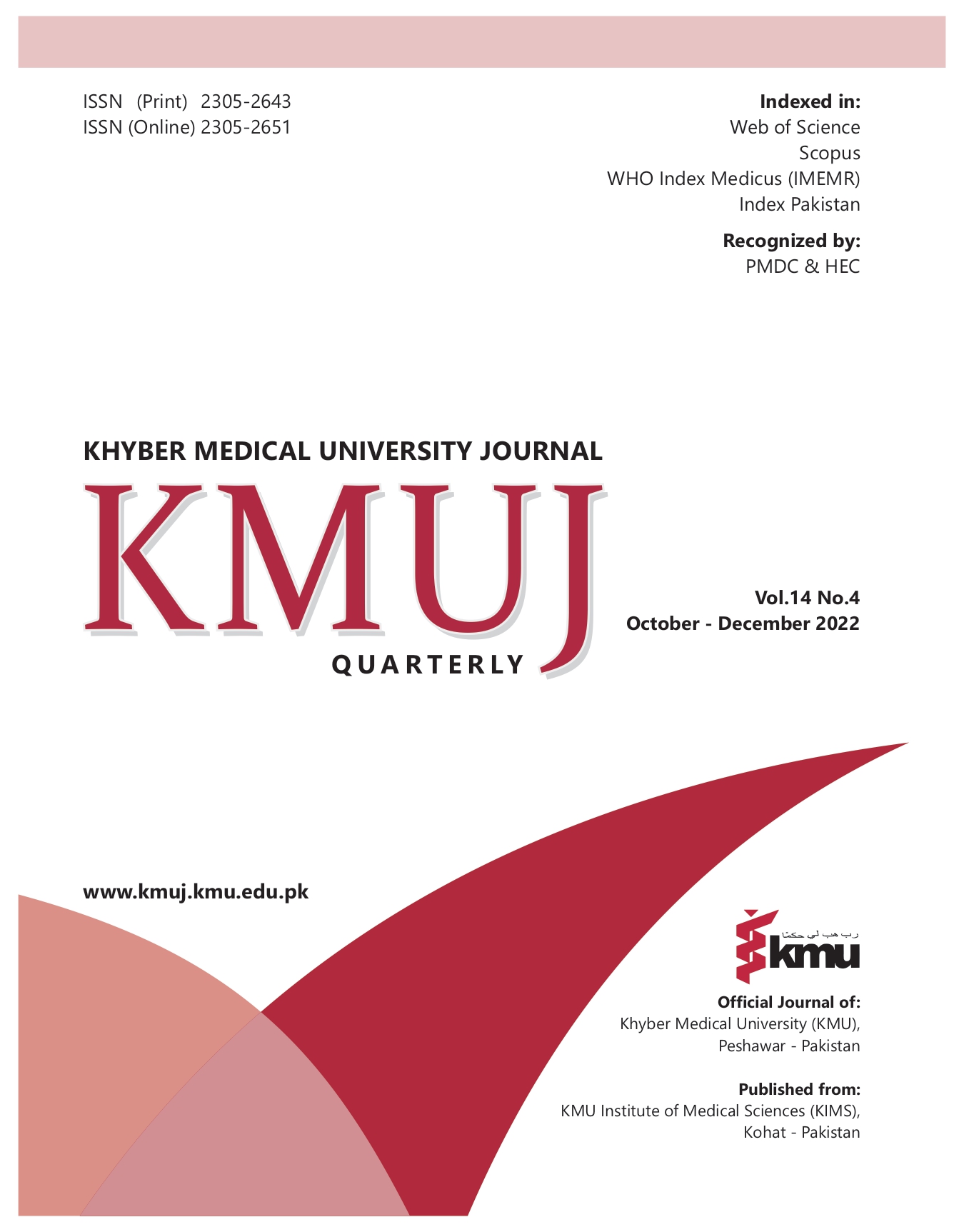INFLUENCE OF DEATH ANXIETY ON THE PREVENTIVE PRACTICES OF HEALTHCARE PROFESSIONALS DURING COVID-19 OUTBREAK
Main Article Content
Abstract
OBJECTIVES: To ascertains the degree of death anxiety in healthcare professionals and their preventive practices during the ongoing pandemic and to find correlations between these two variables.
METHODS: This cross-sectional study was conducted on healthcare professionals working in Combined Military Hospital, Lahore, Pakistan, from July 2020 to February 2021. A descriptive online questionnaire was distributed to measure demography, death anxiety using Collette-Lester Fear of Death Scale Revised and preventive practices using the prevention section of WHO European Region COVID-19 survey tool and guidance. Data were analyzed using SPSS version 24.
RESULTS: Out of 136 subjects, 65 (47.8%) were male and 71 (52.2%) were female. Median (IQR) age of the participants was 28 (26-40) years. Median total degree of death anxiety was 83 (66-107). The four subscales showed Median (IQR) scores as follows: your own death 18 (12-27), your own dying 20 (15-27), the death of others 23 (18-28), and the dying of others 22 (16-29). Death anxiety was mild in 55 (40.4%), moderate in 65 (47.8%) and high in 16 (11.8%) participants. Significant association of female gender (p=0.002), experience of death of a patient (p=0.001) or loved one (p=0.001) was found with death anxiety. Zero participants recorded a high preventive practice score.
CONCLUSION: A significant proportion of healthcare professionals suffered from undiagnosed moderate levels of death anxiety. The level of preventive practices amongst healthcare professionals was moderate to low. Death anxiety had no correlation with preventive practices. Further study is required to investigate the reason behind these unconventional findings.
Article Details
Work published in KMUJ is licensed under a
Creative Commons Attribution 4.0 License
Authors are permitted and encouraged to post their work online (e.g., in institutional repositories or on their website) prior to and during the submission process, as it can lead to productive exchanges, as well as earlier and greater citation of published work.
(e.g., in institutional repositories or on their website) prior to and during the submission process, as it can lead to productive exchanges, as well as earlier and greater citation of published work.
References
World Health Organization. COVID-19 Public Health Emergency of International Concern (PHEIC) Global research and innovation forum. [Accessed on: March 16, 2020]. Available from URL: https://www.who.int/publications/m/item/covid-19-public-health-emergency-of-international-concern-(pheic)-global-research-and-innovation-forum
Arshad AS, Baloch M, Ahmed N, Arshad AA, Iqbal A. The outbreak of Coronavirus Disease 2019 (COVID-19)-An emerging global health threat. J Infect Public Health 2020;13(4):644-6. https://doi.org/10.1016/j.jiph.2020.02.033
Rajkumar RP. COVID-19 and mental health: A review of the existing literature. Asian J Psychiatr 2020;52:102066. https://doi.org/10.1016/j.ajp.2020.102066
Dubey S, Biswas P, Ghosh R, Chatterjee S, Dubey MJ, Chatterjee S, et al. Psychosocial impact of COVID-19. Diabetes Metab Syndr 2020;14(5):779-88. https://doi.org/10.1016/j.dsx.2020.05.035
Mumtaz M. COVID-19 and mental health challenges in Pakistan. Int J Soc Psychiatry 2021;67(3):303-4. https://doi.org/10.1177/0020764020954487
Russac RJ, Gatliff C, Reece M, Spottswood D. Death anxiety across the adult years: an examination of age and gender effects. Death Stud 2007;31(6):549-61. https://doi.org/10.1080/07481180701356936
Vizheh M, Qorbani M, Arzaghi SM, Muhidin S, Javanmard Z, Esmaeili M. The mental health of healthcare workers in the COVID-19 pandemic: A systematic review. J Diabetes Metab Disord 2020;19(2):1067-78. https://doi.org/10.1007/s40200-020-00643-9
Xiang Y-T, Yang Y, Li W, Zhang L, Zhang Q, Cheung T, et al. Timely mental health care for the 2019 novel coronavirus outbreak is urgently needed. Lancet Psychiatry 2020;7(3):228-9. https://doi.org/10.1016/s2215-0366(20)30046-8
Chiu NC, Chi H, Tai YL, Peng CC, Tseng CY, Chen CC, et al. Impact of Wearing Masks, Hand Hygiene, and Social Distancing on Influenza, Enterovirus, and All-Cause Pneumonia During the Coronavirus Pandemic: Retrospective National Epidemiological Surveillance Study. J Med Internet Res 2020;22(8):e21257. https://doi.org/10.2196/21257
Hashim Y. Determining sufficiency of sample size in management survey research activities. Int J Org Manag Enterperneurship Dev 2010;6(1):119-30
World Health Organization (WHO). WHO Regional Office for Europe. Survey tool and guidance: behavioural insights on COVID-19. [Accessed on: July 02, 2020]. Available from URL: https://www.euro.who.int/__data/assets/pdf_file/0007/436705/COVID-19-survey-tool-and-guidance.pdf
Lester D, Abdel-Khalek A. The Collett-Lester fear of death scale: a correction. Death Stud 2003;27(1):81-5. https://doi.org/10.1080/07481180302873
Salari N, Khazaie H, Hosseinian-Far A, Khaledi-Paveh B, Kazeminia M, Mohammadi M, et al. The prevalence of stress, anxiety and depression within front-line healthcare workers caring for COVID-19 patients: a systematic review and meta-regression [Internet]. Hum Resour Health 2020;18(1):100. https://doi.org/10.1186/s12960-020-00544-1
Rachel E, Menzies RG. Death anxiety in the time of COVID-19: theoretical explanations and clinical implications. Cogn Behav Therap 2020;13:e19. https://doi.org/10.1017/s1754470x20000215
Reynolds F. How doctors cope with death. Arch Dis Child 2006;91(9):727. https://doi.org/10.1136/adc.2005.092015
Russac RJ, Gatliff C, Reece M, Spottswood D. Death anxiety across the adult years: an examination of age and gender effects. Death Stud 2007;31(6):549-61. https://doi.org/10.1080/07481180701356936
Assari S, Lankarani MM. Race and gender differences in correlates of death anxiety among elderly in the United States. Iran J Psychiatry Behav Sci 2016;10(2):e2024. https://doi.org/10.17795/ijpbs-2024
Atif K, Khan HU, Zia-Ullah M, Shah FS, Latif A. Prevalence of anxiety and depression among doctors; the unscreened and undiagnosed clientele in Lahore, Pakistan. Pak J Med Sci 2016;32(2):294-8. http://dx.doi.org/10.12669/pjms.322.8731
Parkes CM. Bereavement in adult life. BMJ 1998;316(7134):856-9. https://doi.org/10.1136/bmj.316.7134.856
Ali S, Noreen S, Farooq I, Bugshan A, Vohra F. Risk Assessment of Healthcare Workers at the Frontline against COVID-19. Pak J Med Sci 2020;36(COVID19-S4):S99-S103. https://doi.org/10.12669/pjms.36.COVID19-S4.2790
Anonymous. Death toll of healthcare workers in Pakistan due to COVID-19 reaches 100. [Accessed on: April 12, 202]. Available from URL: https://www.aninews.in/news/world/asia/death-toll-of-healthcare-workers-in-pakistan-due-to-covid-19-reaches-10020201201185445/
Kumar S. Burnout and doctors: prevalence, prevention and intervention. Healthcare (Basel) 2016;4(3):37. https://doi.org/10.3390/healthcare4030037
Amanullah S, Ramesh Shankar R. The Impact of COVID-19 on Physician Burnout Globally: A Review. Healthcare (Basel) 2020;8(4):421. https://doi.org/10.3390/healthcare8040421
Nia HS, Lehto RH, Ebadi A, Peyrovi H. Death anxiety among nurses and health care professionals: A review article. Int J Community Based Nurs Midwifery 2016;4(1):2-10.
